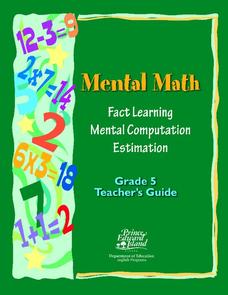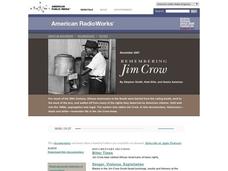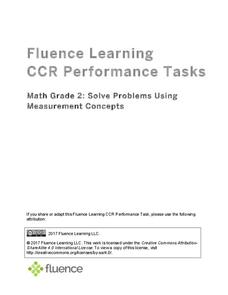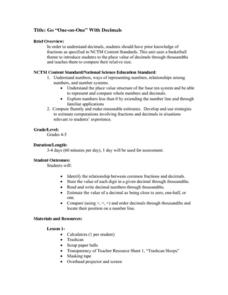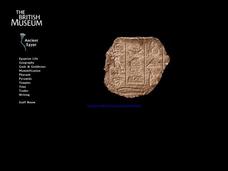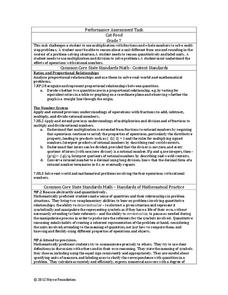Prince Edward Island
Fact Learning, Mental Computation, Estimation
Need help with mental math in your classroom? This guide is full of tips, tricks, and examples to help the teacher encourage learners to use their brain instead of a calculator. Practice problems are included with reasons how...
Balanced Assessment
Fermi Area
Discover creative ways to use surface area formulas. In the assessment task, scholars apply estimation strategies to determine surface area in non-routine problems. They consider surface area of kitchen sponges, rock salt crystals, and...
Curated OER
Counting (Up to 120)
These five sets of objects provide a counting challenge for learners: will they discover strategies to make their job easier? Each array has between 44 and 95 objects in rows. Have learners do the first one, then review their strategies....
Curated OER
Soaring Towers
How tall can your tower get? Implement shapes, building strategies, teamwork, and prediction in this interactive tower activity. Learners discuss past experiences with stacking materials, recalling ways they kept it from falling over....
Balanced Assessment
Fermi Length
How long does it take to get to the end of a toilet paper roll? Pupils use their estimation strategies to find lengths of common items. For example, knowing the area of a roll of toilet paper, scholars determine the length of the full roll.
Curated OER
Problem Solving: Guess and Check
Sometimes guess and check is the best way to solve a word problem. Learners use the guess and check strategy to solve each of the 6 included story problems. Note: At times younger children have difficulty using estimation or the guess...
Didax
Pi Day #1a – Discovering Pi
Unravel the mystery behind the infamous number pi. Scholars complete a series of activities that explores where pi comes from, its digits and estimation strategies. Pupils should be ready to measure, calculate, and look for patterns to...
Scholastic
Mathematics
Three word problems prompt young learners to review their test-taking skills. Each problem provides five possible answers, allowing kids to use the most efficient strategy when solving for the answer.
Illustrative Mathematics
Reasoning about Multiplication and Division and Place Value, Part 1
Help your class make sense of quantities and their relationships. Given is the product of two numbers. It is up to your number crunchers to think about the quantitative relationship when the product is one-tenth or ten times the product...
Balanced Assessment
Fermi Number
A fermi number is a rough estimate of a quantity that is difficult or impossible to measure. Individuals design a process for making an estimation of a given scenario. For example, they determine a plan for estimating the number of...
Balanced Assessment
Catenary
Develop a model for a hanging chain. Pupils find a mathematical model for a hanging chain and then they compare their models to the precise function that models the curve. Scholars come up with a strategy to determine how close...
Fluence Learning
Solve Problems Using Measurement Concepts
Young mathematicians demonstrate what they know about measurement with a four-task assessment that focuses on estimation, length, and inches.
Curated OER
Estimating Quotients
Put down those calculators! Show scholars they can solve division problems mentally using rounding strategies. They divide four-digit dividends by one-digit divisors, competing 26 problems in all. The first eight have some scaffolding...
Curated OER
Rounding To The Nearest Ten And Hundred
In this rounding to the nearest ten and hundred worksheet, students, with a partner, calculate the answers to nine word problems or mathematical equations dealing with estimation.
Curated OER
Estimating Sums
In this estimating sums worksheet, students, working with a partner, practice problem solving five word problems involving estimation.
Curated OER
Mystery Jars: Make Your Own
There are many ways to implement this estimation and counting activity. Young mathematicians fill jars with objects to create "mystery jars." Add difficulty by using smaller objects. After counting, learners secretly record their exact...
National Security Agency
Go One-on-One with Decimals
Shoot and score with three basketball-themed lessons about decimals. Young mathematicians compare game statistics, make trash can hoops, and play a data spinner game to practice identifying digits and values within decimal numbers.
Yummy Math
US Holiday Candy Sales
Candy is a big business! Calculate the amount of money consumers spent on major holidays—Easter, Halloween, Christmas, Hanukkah, and Valentine's Day—based on the total amount of candy sales from 2011 and the percentage of each holiday's...
Illustrative Mathematics
Reasoning about Multiplication and Division and Place Value, Part 2
The learner puts reasoning and estimation to work. The directions are to place a decimal in the answer to make the equation true. Pupils are to look at the two problems, one multiplication and one division, and estimate an answer. No...
Noyce Foundation
Cat Food
Determine the right mix of cans of cat food. The resource consists of an assessment task to determine the cost to feed two cats for a specific number of days and requires scholars to interpret remainders within a context....
Teach Engineering
Show Me the Money
Class members learn how to estimate the total costs involved to design and build a bridge by including design, material, equipment, and labor costs. The activity includes a discussion about the trade-off between cost and aesthetics.
Concord Consortium
Full of Beans
Scholars have an opportunity to use their geometric modeling skills. Pupils determine a reasonable estimate of the number of string beans that would fill the average human body.
EngageNY
Dividing Fractions and Mixed Numbers
Class members discover how to extend division to fractions to mixed numbers. Individuals first review how to convert mixed numbers to improper fractions and then apply division strategies learned in previous lessons. A memory game...
Willow Tree
Perimeter of Common Geometric Figures
Help learners understand that perimeter and circumference are one in the same. Learners apply their skills to determine the perimeter/circumference of triangles, rectangles, and circles. They then use the same strategy to find the...
